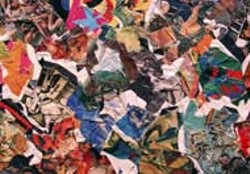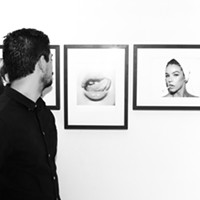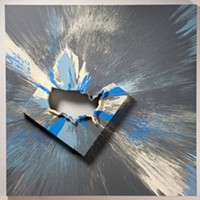Rousso's show The Rebirth of Now is the first show for Kanvas Gallery, a new venture for owner Albert Moore. It's an appropriate title for a premier show in a new gallery with a new owner showing a re-emerged man in our continually reinvented city. What better fit possible for culture intoxicated with the cult of the new? Nothing could be finer.
This show covers more than five years and a number of incarnations of Mr. Rousso. There are second acts in American lives; this country applauds the falling and rising tides of personal reinvention. Rousso seems to have made a habit, perhaps an art, of the process. These 64 works document his second and third acts.
"Fund Raiser" is a 3'x4-1/2' miniature panorama of a fundraiser. The painting illustrates partiers of the fantasy gala event in a twisted, glitzy and fast-framed frenzy — a feeling perhaps recognizable to those frequenting such events. Faces of the partygoers run in single point perspective from the bottom to the top of the canvas, from full faces to the back of the ballroom. Individual faces are doubly or triply superimposed, showing two or three expressions of the same person. Many of the face overlays are smudged and distorted, referencing English artist Francis Bacon's technique for plumbing the dark personality recesses in his portraits. The disquieting technique infuses a twitchy, frenetic quality to the painting.
Body and facial features are shifted slightly, mimicking movement. Fleshy photographs are stacked and mashed. It's a regal parade of privilege and conspicuous indulgence — pearl and diamond necklaces, perfect white teeth chasing lobster tails with champagne, drunken leers and tailored tuxes trailing painted nails and cleavage. The sea of faces is patinaed with countless perfect smiles. Incongruous opulent interiors of velvet curtains, glass atriums, gilded ornaments and Corinthian columns loom over and behind the fleshy fundraisers. This money, alcohol and cigarette-fueled congregation of partiers is stuck on overdrive. It must be fun to give away money.
In three separate pieces, American flags are frozen into permanent crumpled rectangles. The red, white and blue is folded and mashed to countless ridges, coves and valleys. The surface is as slick and shiny as plastic melted with a blow torch. The flags are neither besmirched nor desecrated, but warped and permanently misaligned, as if viewed from underwater as the fabric folds and undulates on the water's surface. They are my least favorite here, coming off as an unhappy compromise wrung out by Jasper Johns, Peter Max and Claes Oldenburg.
"Sex and Violence" is a full frontal fusion of compliance and assault. Viewed from 15 feet away, the collage of guns and poses is an indecipherable typhoon of peachy flesh and blue steel, both hard edged and ambiguous. From 10 feet away, explicit forms emerge: Nipped and tucked from left to center are knees, butts, lips, heads and nipples; on the right side are pistol grips, triggers, barrels, cylinders and hammers. Left to right flesh morphs to titanium, pliable peach to blue black steel. Up close and squinty, it's all seamlessly fragmented, manmade tools and man-handled trade.
We proceed from the profane to the divine. "The Bible" (30"x80") and its forebear, "The Torah," are the best paintings here. This Bible is ripped to bits and reconstituted on a large rectangular canvas closely proportional to a dollar bill. The ink in the paper has a slight green cast and from a distance I thought I was looking at shredded and mashed dollar bills. Muted blacks weave within a yellowed paper ground. The top left corner begins with Genesis and the top right corner ends with Revelations. On a narrow section of the canvas, right of center, a rust-red wisp of smoke trails vertically down the canvas. Rousso tells me the words of Jesus were written in red in the copy he used, which accounts for the only wash of color right after the New Testament begins. This is the least color-aggressive painting in the show. With the Bible and the Torah, Rousso leaves his familiar aggressive graphic world behind.
Imagine a guy at 2am in his backyard studio. He stands in front of a canvas and makes giddy micro decisions. There are no bills, no dirty dishes, no domestic discord lurking at the back door — hell, there's no tomorrow morning. Everything that is, is here, under the halogen lights in the unconditioned late spring night air, in front of the canvas. It's right now and one more critically important splotch of yellow. Here-And-Now is a good place to be. Paul Rousso is having fun.
But who is this man? What is this art? Rousso is a disappearing act: He's somewhere in these paintings but I can't find him. He's hidden among the dozens of other artists here, under Andy Warhol's wig, swirling in Jackson Pollack's tumbler or peeking out from behind Robert Rauschenberg's color transfer. He's here somewhere.
"Art of the 20th Century" is one of Rousso's latest paintings, one of his best, and the first one of the rest of his painting life. It is the physical dissolution of the coffee table book by the same title, a crumpled, torn and pasted reduction of every historical high art influence of the last century. This collage is an all-over field painting, an edge-to-edge uniform reduction of countless images to a single field of arranged spectral color — dark and light, no figure, no ground. Figuratively, it's point of rebirth — a masticated, swallowed and digested body of information every artist will either assimilate or leave in his rear view mirror.
Looking at this show is like standing behind a plate glass window watching pieces of the best paintings of the last 100 years being wadded up, wetted down and spitballed in my direction. The wadded fragments flatten on the glass at my nose and eventually fill my field of vision. It's all there right in front of me — hurled and stuck to cover my entire window of perception, but it's too fast and too fragmented, and the whole process has been like a fevered, sped up dream.
Paul Rousso's show The Rebirth of Now runs through June 25 at Kanvas Gallery, 318 E. 9th St. (in Joie Lassiter's old digs). The gallery is the single story yellow brick building at 9th and Brevard. It's open 6-9pm Thursdays and Fridays and by appointment. Call 704-342-9950 for details.
Latest in Feature
More by Scott Lucas
Calendar
-

WHISKEY TASTING: VIRGINIA HIGHLANDS WHISKY @ Elizabeth Parlour Room
-
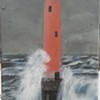
NEW WINDOW GALLERY-Pat Rhea-ACRYLIC PAINTINGS-April 05-30 2024 VALDESE, NC 28690 @ New Window Gallery/Play It Again Records
- Through April 30, 12 p.m.
-
An Evening With Phil Rosenthal Of "Somebody Feed Phil" @ Knight Theater
-
Kountry Wayne: The King Of Hearts Tour @ Ovens Auditorium
-
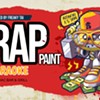
Trap & Paint + Karaoke @ Zodiac Bar & Grill

